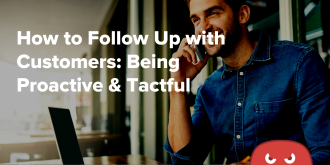Quick Links
Online ads are becoming less effective.
Eye-tracking studies have shown that online users tend to ignore ads and head straight to the content they’re looking for.
This behavior is known as banner blindness — a form of selective attention where users ignore ads or sections of a website that don’t have useful information.
If visitors are ignoring your ads, you won’t generate as many clicks and conversions as you’d like. So, how can you reach your audience online in a non-invasive manner?
One way is with sponsored content.
If you’re not already using sponsored content in your marketing mix, you’re missing out on opportunities to reach and engage your target audience.
In this article, we’ll break down what sponsored content is, showcase different types, and provide examples of how to leverage this channel to drive measurable results.
What is sponsored content?
Sponsored content is a type of paid advertising where you work with blogs, newspapers, YouTube channels, or other sites to publish promotional content. Unlike traditional ads that are often intrusive, sponsored content appears more organic as it looks like ordinary editorial content.
The way it works is simple — a company partners with a publisher or content creator who agrees to publish content in exchange for payment (or another perk).
If you’re on social media, there’s a good chance you’ve seen sponsored content in action from the brands or people you follow.
Audible, a subscription service for audiobooks, regularly partners with influencers. In the post below, photographer Jesse Driftwood talks about using Audible to listen to audiobooks on business management and productivity.
Why bother with sponsored content?
Let’s face it:
Nobody likes ads.
You’re reading an interesting story, and an ad suddenly takes up the entire screen. Or you’re watching a YouTube video, and just as things are about to get juicy, it cuts to a commercial.
It’s not at all surprising that 41% of respondents are often annoyed by advertising on the internet. Over 763 million internet users use adblock to avoid them completely.
People don’t like ads, and many go out of their way to block them (guilty).
Sponsored content can help you reach your audience in a non-intrusive manner. Because it resembles editorial content, people are more likely to engage with it.
This can help you:
- Raise brand awareness
- Educate your audience
- Build trust and credibility
- Establish thought leadership
If users get value from your content, they’ll likely continue interacting with your brand in the future and may even become customers.
Sponsored content vs. native advertising
There’s often some confusion between sponsored content and native advertising, so let’s clear these terms up before we continue.
Native ads
Native ads are a form of paid advertising that matches the look and feel of the platform they reside on. They’re designed to be less intrusive than traditional ads like banners and pop-ups.
Most native ads include the following:
- Headline
- Product image
- Short description
- Call to action
Here’s an example of an in-feed social media ad:
The ad blends in with the surrounding content and platform (Instagram). Someone scrolling through their newsfeed may not even realize that it is an ad.
Paid search ads are another example of native ads.
Searching for “small business accounting software” in Google, we saw these ads at the top of the search results:
You can tell these are ads because they’re marked as “ads,” but they still resemble other search listings.
Finally, another popular format for native ads is paid content that appears below an article, as shown below.
Clicking on these types of ads typically directs visitors to a landing page where they can learn more about a product and make a purchase.
Native ads can certainly help you generate sales. However, some visitors may find it off-putting when you push them towards a conversion too soon.
Then there’s the issue of ad blindness, in which visitors may scroll past your ads or ignore them altogether. Using sponsored content may be a better option to reach your audience.
Sponsored content
Sponsored content is a completely different approach to native advertising. It takes the form of an article, video, or social media post.
Native ads are created by advertisers, but sponsored content is often created by the publisher or content creator. While brands can still create their own sponsored content, they must work with the publisher to ensure it fits their audience.
Sponsored content isn’t as “salesy” or direct as native ads. Instead, it aims to educate rather than sell. Because sponsored content looks like any other post, users are less likely to ignore it.
One thing to note before we continue is that the Federal Trade Commission (FTC) requires publishers and influencers to disclose when they have a “material connection” to a brand.
Material connection means that a publisher is receiving some financial benefit or perk when working with a brand. They must make it clear when their posts are sponsored (generally with a disclaimer like “Sponsored by…” or hashtag like #ad).
Types of sponsored content (with examples)
Creating sponsored content can be an effective way to raise brand awareness, showcase your expertise, and build trust with your audience.
Here’s a look at different types of sponsored content. We’ve also provided examples of how companies are using these content formats to drive engagement.
Articles
Articles are the backbone of most companies’ content creation efforts and are also one of the best ways to utilize sponsored content. They can help you reach and connect with audiences on platforms that match your buyer persona.
Dropbox sponsored an article in The New York Times, describing how three startups successfully launched in 2020 — even with mass layoffs and record business closures.
It also states at the top that it’s a paid post to avoid misleading users.
While the article touches on how each startup used Dropbox to collaborate, it focuses more on educating and providing value.
Interested in getting professional long-form content written for your business? Get started with HOTH Blogger, and we’ll take care of the rest.
Videos
Long-form content (anything over 1,000 words) is a great way to dive into a topic and provide more information. However, some people may prefer watching videos.
Sponsored videos can help you reach new audiences and even generate sales. In fact, 84% of people have purchased a product or service after watching a brand’s video.
Investment firm BlackRock sponsored a series of financial well-being videos for popular news outlet NowThis News.
The sponsored videos provide financial advice on budgeting, investing, and more. It’s a perfect match for BlackRock as it offers investment management solutions.
Social media
Social media platforms like Facebook and Instagram are a huge part of consumers’ lives.
It makes sense that brands are investing more in sponsored content for social media. In fact, companies spent an estimated $13.8 billion on influencer marketing in 2021.
Sponsored posts on platforms like Instagram and Facebook give you the opportunity to increase brand awareness and drive referral traffic to your site.
TUMS, an over-the-counter medication to relieve heartburn, sponsored the following post on First We Feast’s Twitter.
First We Feast produces the wildly popular Hot Ones series. The show’s host interviews celebrities while they eat spicy chicken wings.
While comical, it’s a perfect sponsorship — spicy food can cause an upset stomach, which antacids like TUMS just so happen to relieve.
Podcasts
Podcasts are growing in popularity. An estimated 41% of U.S. adults have listened to a podcast within the last month, a figure that’s more than tripled over the last decade.
Sponsoring a podcast or a segment that’s related to your business can help you tap into this massive market.
WeWork sponsored a segment on flexible workspaces on NPR’s Planet Money podcast.
The podcast focuses specifically on the growing popularity of co-working spaces, something that WeWork offers in cities worldwide. (It’s a great example of sponsored content, despite the company’s ups and downs).
The examples above are just some content types that you can sponsor. Others include:
- Ebooks
- Infographics
- Whitepapers
- Newsletters
- Webinars
- Workshops
- Courses
- Quizzes
- Tools
Now let’s look at how you can start using sponsored content to connect with audiences on different platforms.
How to get started with sponsored content
Sponsored content can drive measurable results for your business when done right. But like any marketing strategy, you’ll need to develop a plan and allocate your resources accordingly.
Follow these steps to promote your brand using sponsored content.
1. Set a goal
Sponsored content is essentially a form of content marketing — a marketing technique focused on creating and distributing valuable content to attract prospects to your site.
The first step to driving results with sponsored content is to establish goals. This will provide a clear direction and keep your efforts on the right track.
Common marketing goals:
- Raise brand awareness
- Increase referral traffic
- Build your reputation online
- Establish thought leadership
- Drive more leads and sales
- Generate quality backlinks
Defining your goals will help provide guidance on the type of content you should create.
Let’s say your goal is to raise brand awareness. In this case, you’d create content that targets the awareness stage of the buyer’s journey. Some examples include educational and how-to articles.
But if your goal is to establish thought leadership, then you might focus more on sponsoring content like whitepapers or original research.
2. Research your target audience
Understanding your target audience is key to creating sponsored content.
Think about the audience that you want to reach. What are their demographics? What do they want to learn more about? What problems are they facing?
Here are some ways to research your audience:
- Collect and explore demographic data: Google Analytics offers plenty of information about your website visitors, like age, gender, interests, and more. You can also explore this data through Facebook Audience Insights and Twitter Analytics.
- Conduct customer surveys: One of the best ways to learn about your audience is to ask them directly. Send out email surveys or even arrange face-to-face meetings with your existing customers if possible.
- Analyze your competitors: Chances are your competitors are using platforms like Facebook and Twitter. Analyzing their pages can also yield valuable insights into your target audience. Pay attention to the content their followers are engaging with and take inspiration from it.
Use the information you’ve gathered to create a buyer persona — a profile that describes your target audience in detail. This will come in handy as you start creating sponsored content.
3. Decide on a content type
Choose a content type that aligns with your goals. For example, if one of your goals is to drive more organic search traffic, you might consider sponsoring long-form content.
HubSpot found that articles with longer word counts generate more traffic on average than shorter articles.
Search engines value content that goes into great depth about a topic, something that’s hard to do with short articles. Sponsoring long-form content can drive more traffic to your pages.
Of course, don’t just limit yourself to one content type.
If you’re only sponsoring blog posts, you’re missing out on a portion of your audience who may prefer watching videos or listening to podcasts. Once you set up a process for sponsored articles, consider expanding into different formats.
4. Research and choose a publisher
The next step is to choose a company, influencer, or publisher to distribute your sponsored content.
Here are some things to consider:
- Audience: Choose a publisher with an audience that aligns with yours. For example, if you’re a travel agency, you might reach out to travel magazines or blogs. Research the platform to learn about their audience.
- Traffic: Creating sponsored content takes a lot of time and effort, so you want to make it worth your while. Use our free website traffic checker tool to estimate how much traffic a publisher receives a month.
- Cost: Find a publisher that fits your budget. How much you can expect to pay will depend on factors like demographics, reach, engagement, and content format.
Once you find a promising publisher, reach out and request a media kit — a document that contains information about its audience and other details like engagement metrics.
Of course, don’t forget about social media influencers on social media. 61% of consumers trust product recommendations from influencers.
Working with the right influencers can have a positive impact on your bottom line.
5. Create your sponsored content
Often, publishers and creators will want to create the sponsored content themselves. For example, T Brand Studio is a branch of The New York Times that works with companies to create branded content (like the Dropbox content we saw earlier).
However, if you need to create your own sponsored content, then keep the following in mind:
- Provide value: Always focus on providing value no matter what publisher you choose to distribute your content. If your content is too promotional, readers may simply tune out, or the publisher may reject it.
- Include multimedia: Nobody likes to read large walls of text. Include multimedia like images and videos in your article to increase engagement. Bloggers who include at least ten images report stronger results than those who use fewer images.
- Follow editorial guidelines: Many publications have strict guidelines of what they can and can’t accept. Make sure that you stick to these editorial standards to get your content accepted.
- Optimize for SEO: Don’t forget to optimize your sponsored content to improve its rankings in the search results. Use our free Google Keyword Planner Tool to identify keywords you can target.
- Match the content to the platform: Readers of most publications have preferences and expectations about new content. When you’re creating sponsored content, make sure that you match its voice and tone to the platform you’re publishing on.
If you’re looking to get professionally written content, then check out HOTH Blogger.
6. Measure your results
The results you can expect will depend on the content and platform you publish on.
For example, sponsored posts on social media can drive engagement and referral traffic almost immediately. But these results will start to drop off once a content creator posts new content.
In contrast, it can take some time for sponsored articles to gain traction. But they can drive more traffic to your site in the long term.
Use tools like Google Analytics to measure your traffic. Give the publisher or creator a link with a unique UTM tag to track your results. You can also use tools like BuzzSumo to track social media activity and mentions of your content.
Gather as much data as you can about your sponsored content. This will help you decide which publishers and content type you should continue investing in.
Conclusion
Consumers today are bombarded with ads.
It’s gotten to the point that many internet users ignore ads on web pages or even install software to block them entirely.
Sponsored content can help you reach your audience in a non-invasive way and even improve your brand’s credibility. Follow the steps laid out here to include sponsored content in your marketing strategy.
Need help creating sponsored content for your company?
Schedule a call with our digital marketing experts to learn more. We’ll help you research topics and create professionally-written content that builds your authority online.


























Great Info In This Blog Thanks For Sharing This